Maikel Garcia Is Leveling Up
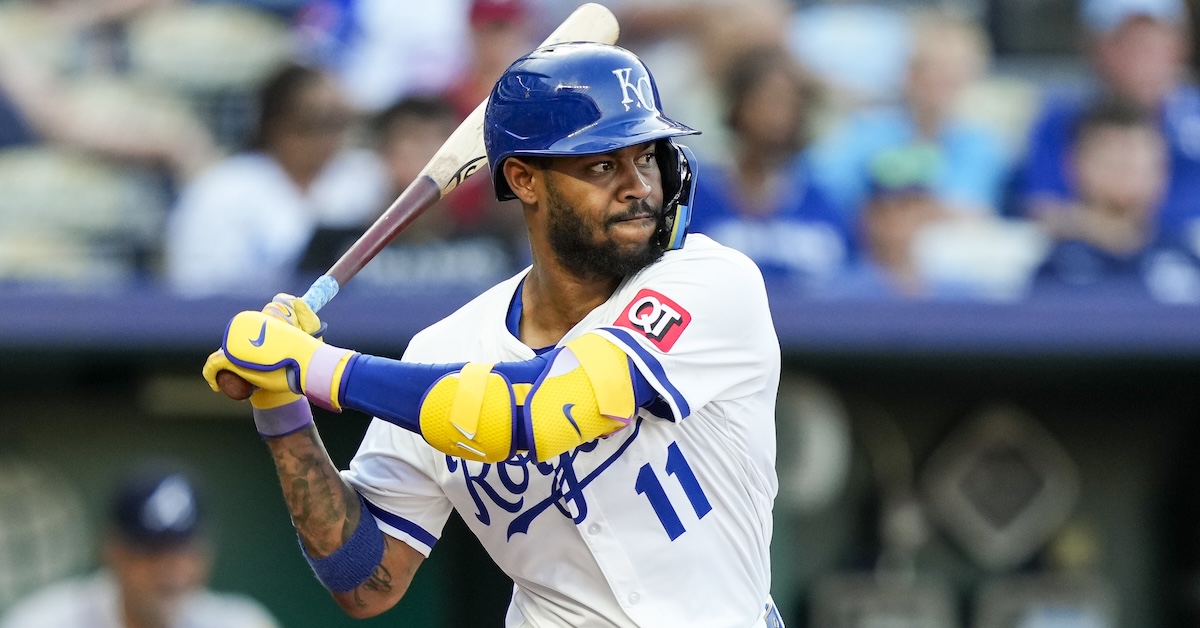
We thought we knew what to expect from Maikel Garcia. Coming into his third full season in the majors, the Royals third baseman had a career wRC+ of 77, but thanks to his 17 OAA, he’d put up 3.4 WAR. That added up to a story as old as time – or at least as old as Ke’Bryan Hayes – a good-not-great, all-glove everyday third baseman. This season, Garcia is blowing up that narrative.
Garcia came up as a shortstop, but with Bobby Witt Jr. set to lock that position down for the next decade or two, he quickly settled in as one of the best defensive third basemen in the game. As for the bat, well, he didn’t chase, he made tons of contact, and he hit the ball hard. He just couldn’t get it in the air. A total of 303 batters made at least 1,000 plate appearances between 2021 and 2024. Garcia’s 45.7% hard-hit rate ranked 60th among them, but his average launch angle of 6.2 degrees ranked 285th. As a result, his .344 slugging percentage ranked 293rd. The package worked, especially after Garcia became one of the best baserunners in the game in 2024, but it was hard to look at him without fixating on that one big thing he couldn’t seem to do.
Hayes is just three years older than Garcia, but after spending so much time waiting for him to start lifting the ball, maybe it was a little too easy to write off Garcia’s offensive potential too. The high groundball rate wasn’t his only flaw. Garcia didn’t just have a low chase rate; he was one of the most passive players in all of baseball. With little fear that he’d swing at all, much less somehow turn a groundball into a home run, pitchers absolutely pounded the zone, racking up called strikes and keeping Garcia from turning all that patience into walks. Then 2025 happened.
This season, Garcia has lowered his groundball rate by more than five percentage points, from 49.5% to 44.3%. That’s a huge drop-off, but because he was starting so very high, it still puts him in the top third of the league. His barrel rate still falls in just the 24th percentile, but that’s good enough. He’s got a career high of 12 home runs and he’s raised his slugging percentage to .468. He’s one of just nine qualified players with a .300 batting average, and his 126 wRC+ is an improvement of 56 points from last season. Because he still doesn’t chase, pitchers are left with a much more difficult decision. Garcia is actually swinging even less this season – his 57.6% zone swing rate ranks 145th out of 156 qualified hitters – but all of a sudden, if you throw him a strike, he’s capable of making you regret it. So far, pitchers have kept on choosing Door A and pounding the strike zone. In fact, Garcia 52.1% zone rate is nearly the exact same as it’s been for the past two seasons, and he’s running career-best walk and strikeout rates. If he keeps slugging this way, you have to imagine pitchers will finally show him some respect.
In addition to reaching the minimum acceptable launch angle, Garcia has added some real power. His 90th-percentile exit velocity is at 105.5 mph, up from 104.6 and 104 in the two previous seasons. His average bat speed has jumped from 70.8 mph in 2024 to 71.9 mph in 2025. All of a sudden, he’s combining extreme patience and contact skills with average contact quality, and he’s getting just enough lift to take advantage of it. That’s not usually how things work. It’s great to chase less, but a more passive approach often leads to more passive (read: weaker) swings. And hitting the ball in the air more often usually means steeper swings, which result in higher whiff rates. Garcia has so far avoided both of those pitfalls.
Here’s Garcia’s rolling groundball rate over the course of his entire career. Note that the dotted blue line is his career average, but because he’s lowered it so much this season, I’ve added a bright red line that shows his average coming into the season.
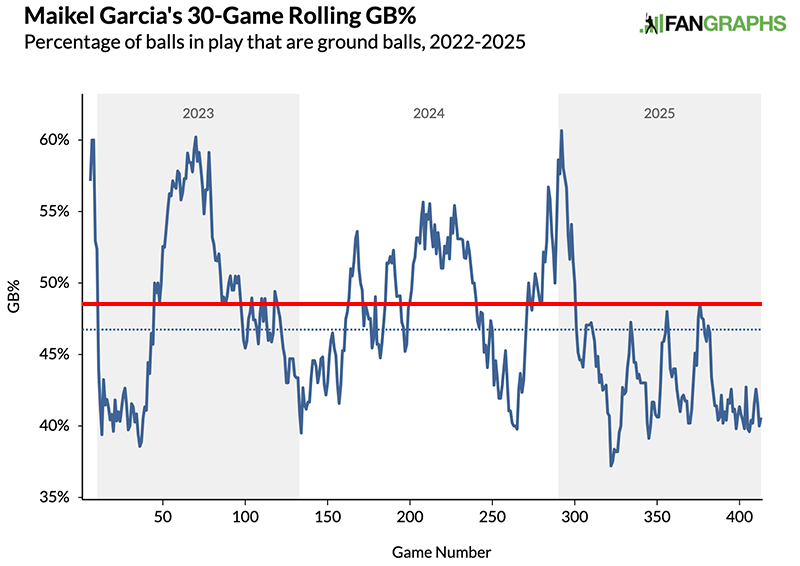
It’s not just that his groundball rate is drastically lower. It’s that even during the periods that he’s hitting the ball on the ground more, he’s only once even touched his previous average. He’s never gone above it, and he’s now 125 games and 518 plate appearances into the season. That’s a pretty big sample. It certainly looks like a whole new Garcia. His average launch angle is up against all three pitch types. In fact, it’s up quite a bit against nearly every individual kind of pitch, with the notable exceptions of changeups and sliders.
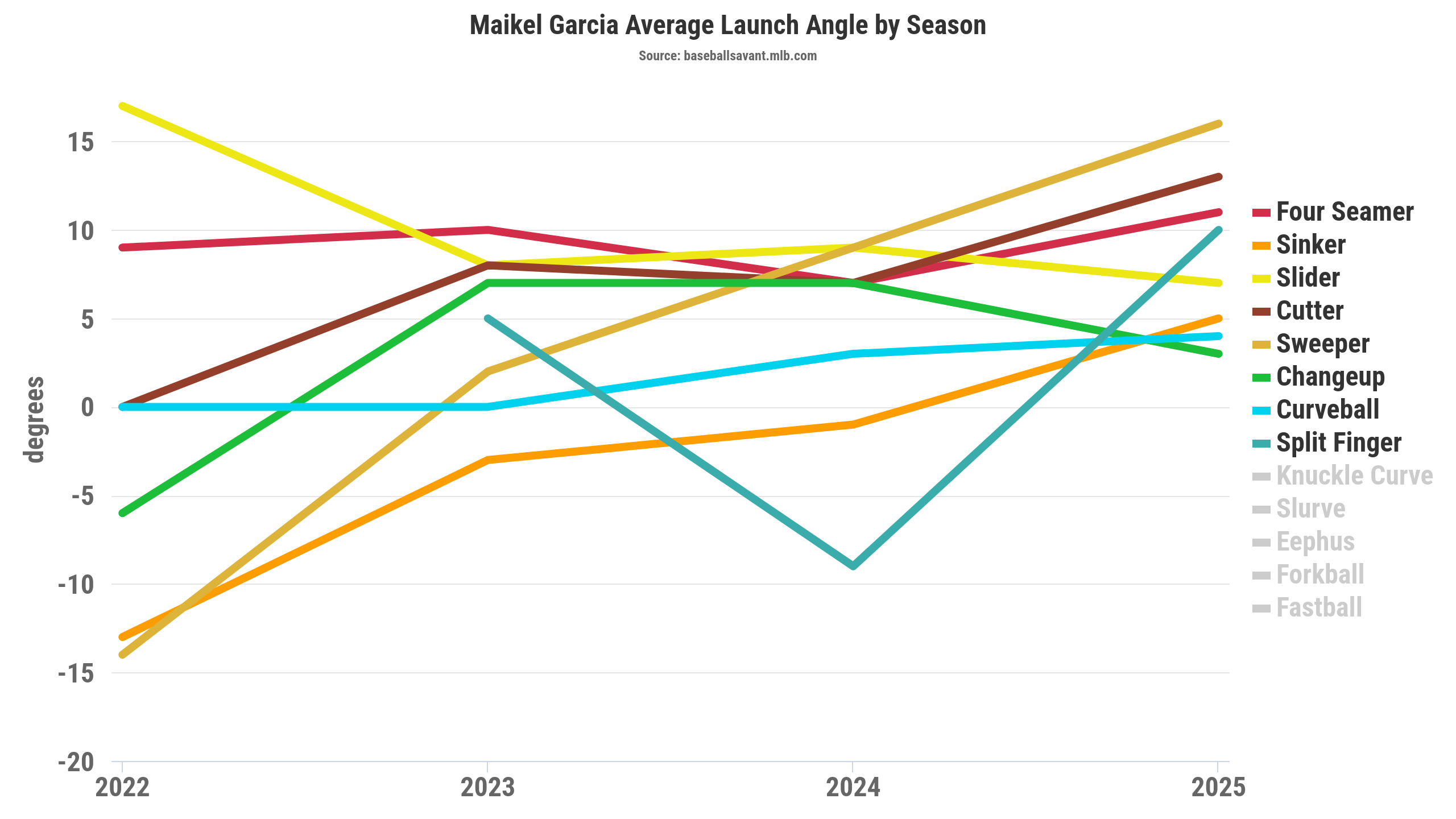
The interesting thing is that Garcia’s swing doesn’t appear to be any steeper. Statcast’s bat tracking metrics show that it’s actually one degree flatter than it was in 2024. That brings us to intention. Garcia tends to play year-round, returning to his native Venezuela for winter ball. However, he had to rest over the offseason because of surgery to remove bone spurs from his right elbow. He rehabbed, spent more time in the weight room, and revamped his swing. Obviously, we shouldn’t trust every player who comes into spring training in the best shape of his life and with a new timing mechanism, but the extra bat speed sure makes it easy to believe that Garcia either added muscle or just feels better after getting his elbow taken care of. As for his swing, Anne Rogers of MLB.com got some excellent details on his adjustments back in February:
The goal this offseason was to figure out how to make better contact.
“It’s more about controlling my body,” Garcia said. “Don’t go too far forward to get to the ball. Wait for the ball. That’s the adjustment I tried to make.”
Garcia has added a small toe tap this spring, which he’s done before and thinks will help him with timing after seeing how many balls he fouled back or to the right last year. But his main priority is to center his weight in his stance rather than falling forward, or what hitting coach Alec Zumwalt likes to call “crashing.” It ends up, among other things, hindering hitters’ swing decisions.
“Crashing, for us, is when the foot gets down and everything is coming behind it with no ability to stop,” Zumwalt said. “So you’re basically in ‘go’ mode, and it’s really hard to adjust. If you guess right, it looks good. You guess wrong, you miss. With Maikel, what gives him so much hitting ability is he’s got such a flat swing through the zone, so he can be a little late and shoot the ball the other way.
“But we’ve talked about getting away from the crashing. He owned it. He felt his weight get too heavy on the front foot and knew he needed to be more adjustable.
…
“There’s a lot of upside there,” manager Matt Quatraro said. “Staying on the fastball, I think is big for him.
Garcia is indeed fouling off fewer pitches, and although they’re still a weakness, he’s been much better against fastballs. But if you compare video from 2024 and 2025, you’ll see that although his batting stance is slightly more open and he’s switched from a leg kick to that new toe tap, his actual swing doesn’t look much different. His feet are spread farther apart, which isn’t necessarily what you’d expect from someone trying desperately to stay back. But as the quotes above make clear, avoiding crashing is less about actually meeting the ball deeper and more about finding a way to stay on time and in position to put a good swing on the ball. Garcia is actually intercepting the ball farther out in front.
There’s no way for us to know whether the toe tap and the emphasis on staying back are the reasons for it, but Garcia’s timing really is better. That’s one way to make more contact while also swinging much harder, but Garcia is swinging harder no matter how you slice up the data. Meeting the ball farther out in front has increased his pull rate, and it’s likely contributed to some of his launch angle gains – a topic that was conspicuously absent in all of the quotes Rogers relayed. The Royals either weren’t worried about that part of the puzzle, or they thought that maybe it would take care of itself if everything else went to plan.
We’ve finally arrived at the million-dollar question: Is Garcia’s newfound ability to elevate the ball sustainable? To answer that, we need to look at how he’s doing it. With Garcia lifting the ball more than ever, you’d expect him to be swinging at higher pitches, right? Wrong.

That’s a little weird. Garcia always liked the ball up and in, but he’s lowered his sights some and is even more focused on the inner half. You don’t normally expect a player to lift the ball more by swinging at lower pitches. That makes the next set of heat maps even weirder. Here are Garcia’s contact rates. (I’ve removed the very edges of the heat maps – the way, way outside pitches – because they were distracting and he never swings at them anyway.)
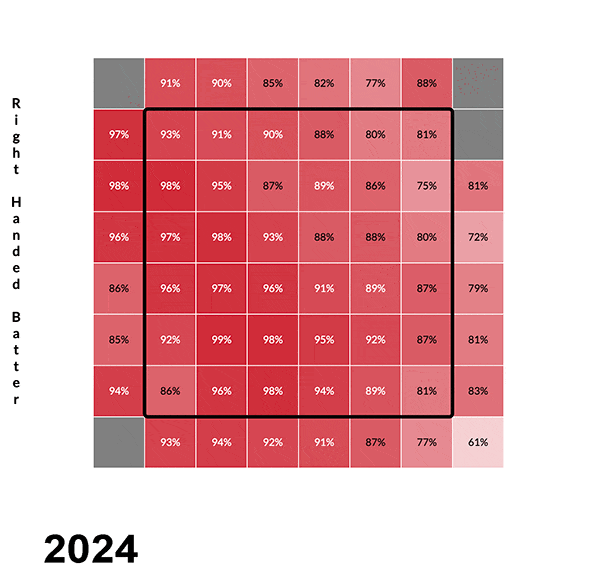
Everything’s red because Garcia is great at making contact no matter where he swings, but there’s a clear shift here, and it’s the opposite of the shift in the preceding heat maps. Even though Garcia is swinging at more pitches inside and down, he’s making less contact there and more contact up and out over the plate. Missing a few more of those low and inside pitches could be helping him hit fewer grounders. Because Garcia is very choosy and because he makes so much contact, these shifts are more subtle than the heat maps make them seem, but it’s strange to see him putting better swings on the ball in the areas where he’s swinging less. Alright, this is our last set of heat maps. I promise. Here is Garcia’s launch angle.
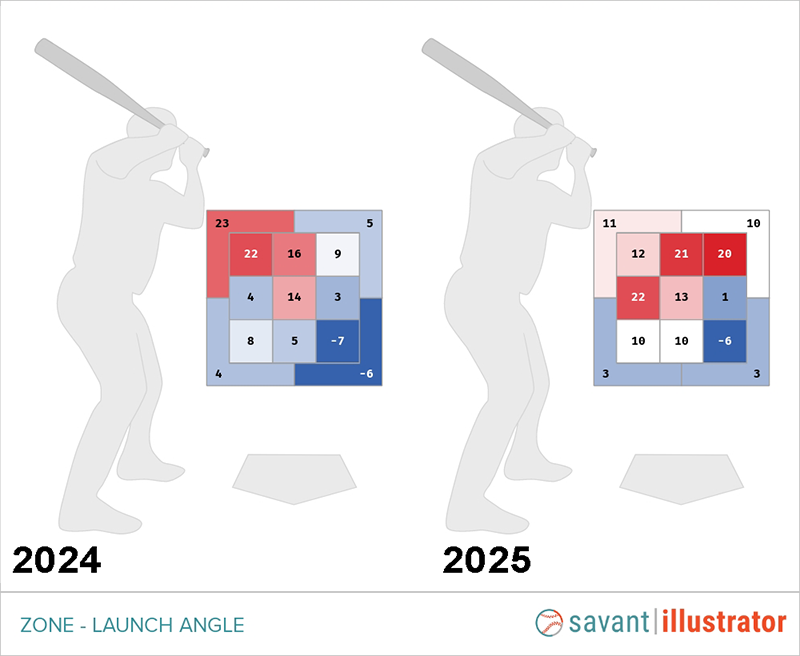
We don’t need to get too hung up on the specifics here. The main point is that Garcia is lifting the ball more often in nearly every part of the strike zone. The exit velocity heat maps show the same thing. When you combine all these different factors, you can see that Garcia hasn’t found one weird trick. He’s not doing one thing that pitchers can easily counter. The numbers don’t show a specific reason that he’s swinging harder or lifting the ball more. He’s just doing it. His average bat speed is higher against every single type of pitch.
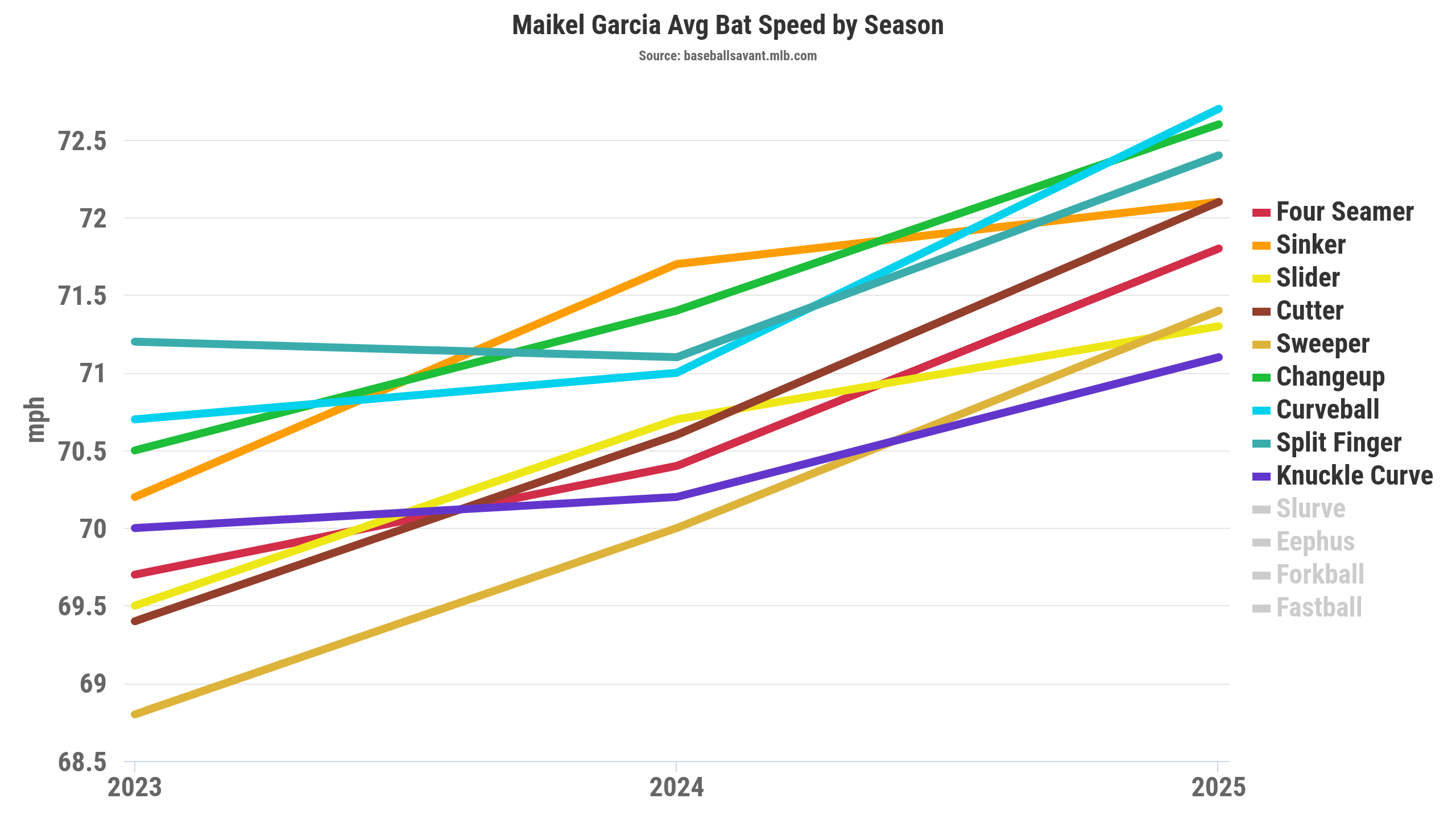
He’s better at catching up to fastballs, which has left him a little more vulnerable to offspeed stuff, but that’s not a bad trade-off for a player who sees tons of fastballs in the zone and who’s great at laying off pitches below it. It also sounds a little familiar. When Eric Longenhagen named Garcia the top prospect in the Royals organization back in 2023, he wrote, “Garcia’s build gives him great long-term athletic projection and he may yet get stronger deep into his 20s, which might enable him to be more on time for the fastballs that he currently tends to foul off rather than barrel.” That’s starting to look awfully prescient. None of this means that Garcia is certain to keep this going forever, but it’s very encouraging. It might be time for pitchers to find a new way to attack him, but I’m not sure how they’ll do it. Although the outcomes have changed, his swing and his approach aren’t all that different. They’re just working.
Davy Andrews is a Brooklyn-based musician and a writer at FanGraphs. He can be found on Bluesky @davyandrewsdavy.bsky.social.
Man thanks for this article I swear to god just yesterday I was looking at the WAR leaderboards, saw Garcia 11th, clicked his player profile and then saw that nothing had been really written about him. That being said, I’m not sure there is a whole lot to say ? I watch him every day and think he is a fine player who got extremely unlucky last year hitting into outs all the time but I have really not noticed much different at the plate this year. It does seem anecdotally like he is getting hit a lot more balls this year that give him opportunities to make plays than in the past and he’s making all of them…but he’s always been an excellent defender so nothing new.
idk seems like Geraldo Perdomo to me where no one really takes either of them seriously as a great player and I don’t really blame people. If Garcia can be a merely league average bat going forward that’s an excellent player but I’m pretty sure he would be more valuable on most non royals teams as a short stop than he is currently
Yeah, I was just saying the other day on another site that Garcia is having one of the quietest ~5 WAR seasons I have ever seen. Nobody outside KC seems to have noticed even with him making the All Star game this year.
You could make a real argument that Garcia has been the best 3B in MLB this season yet he is flying totally under the radar.